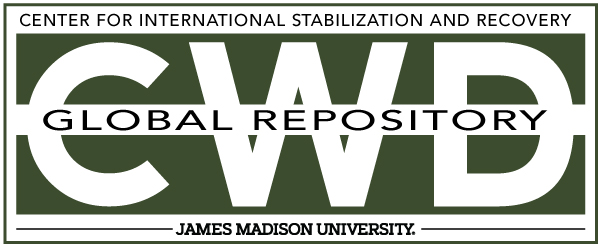Document Type
Other
Creative Commons License

This work is licensed under a Creative Commons Attribution-Noncommercial-No Derivative Works 4.0 License.
Publication Date
7-2012
Keywords
TWEIS, 2011, 12th Edition, Risk Education, Victim Assistance, ERW Clearance, Conventional Weapons Stockpile Destruction, Advocacy and International Law, Centers and Organizations, State Department, Humanitarian Mine Action, Landmine, Clearance, Victim Assistance, Risk Education, Funding, PM/WRA, MANPADS, HMA, Training, Research, Development, PSSM, CISR
Abstract
In 2011, the United States continued to lead the international donor community in providing assistance for the clearance of landmines and explosive remnants of war, as well as the destruction of at-risk and unsecured weapons and munitions. In Fiscal Year 2011, the Department of State allocated $142 million in assistance to 42 countries, thereby helping communities recover, and countries become more secure. This 11th edition of our annual report, To Walk The Earth In Safety, details the programs and partnerships that make the United States’ Conventional Weapons Destruction (CWD) program a lasting success.
Increased instability as a result of sweeping political change in the Middle East and North Africa in 2011 endangered the security of a range of weapons stockpiles across the region. In Libya, the revolution and eventual collapse of the Qadhafi regime brought increased attention to the global threat posed by illicit proliferation of weapons, including man-portable air-defense systems or MANPADS, also known as shoulder-fired anti-aircraft missiles. For the last year, the United States has led an international effort to help Libya secure its conventional weapons stockpiles. Our commitment to stability and security in the Middle East, including Syria and North Africa, ensures that the U.S. will continue working to help reduce illicit weapons proliferation throughout the region. Since 2003, our cooperation with more than 30 countries around the globe has led to the reduction of nearly 33,000 excess, loosely secured, or otherwise at-risk MANPADS by the U.S. CWD program.
While MANPADS remain a top U.S. priority, landmines, unexploded ordnance (UXO), and explosions at poorly maintained depots continue to kill or injure thousands of civilians annually. A tragic example of this occurred in Brazzaville, the Republic of Congo, on 4 March 2012 when a munitions depot exploded, resulting in more than 250 deaths and more than 2,000 injured. UXO was thrown as far as three kilometers (nearly two miles) from the blast epicenter, forcing tens of thousands of families from their homes and posing lingering hazards to emergency responders and complicating recovery efforts. Working in close coordination with national authorities and with technical experts from the United Nations and specialized nongovernmental organizations (NGO), the United States funded and deployed a team of civilian technical experts known as the Quick Reaction Force (QRF) to help dispose of nearly 20,000 items of damaged and unstable munitions. This allowed some area residents to return home and safely rebuild.
Through humanitarian mine action, the United States continues to clear a path to a safer world. We congratulate Burundi, Jordan, Nepal, and Nigeria on declaring themselves mine-impact free this year, and we are proud of the U.S. contribution to their efforts. In 2011, under U.S. chairmanship of the Mine Action Support Group, 24 donor nations and NGOs worked to improve donor coordination around the world. In addition, our increasing engagement in the Pacific has resulted in the continued cleanup of abandoned and unexploded ordnance, mostly from World War II, in the Solomon Islands, Kiribati, and other Pacific nations.
In 2011, our Public-Private Partnership Program grew to almost 70 partners and continued to apply new energy, ideas, and financial resources to the field of CWD, including humanitarian mine action. Partnering with civil society enables us to expand our reach, raise awareness, and encourage grassroots participation.
The United States’ CWD program has contributed close to $2 billion to more than 90 countries to reduce the harmful worldwide effects generated by indiscriminately used, illicit, and abandoned conventional weapons of war since 1993.
I invite you to read this report and learn about the significant conflict-remediation and peace-building efforts the U.S. is making around the world. I extend my appreciation to the U.S. Congress and American taxpayers who support our efforts to help everyone “to walk the Earth in safety.”
Included in
Defense and Security Studies Commons, Peace and Conflict Studies Commons, Public Policy Commons, Social Policy Commons



